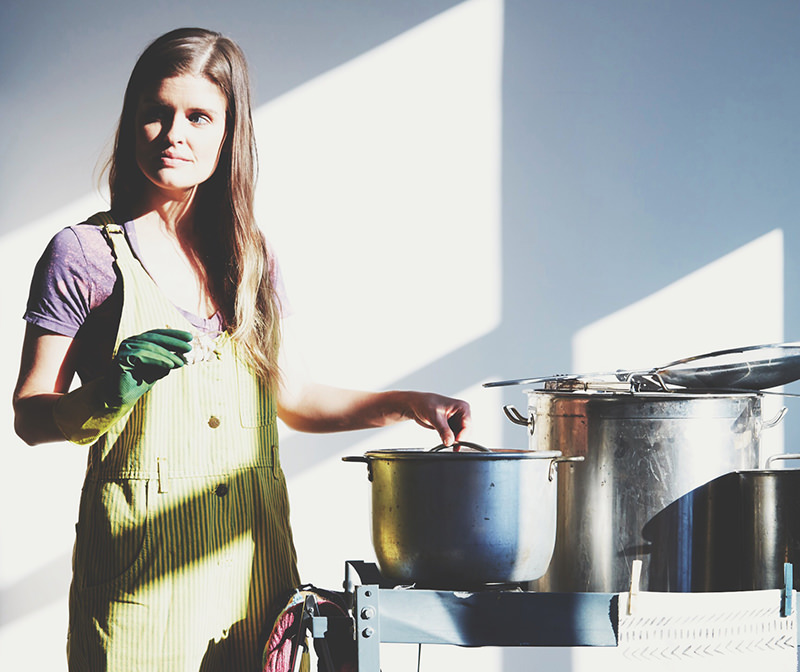
When it comes to sustainability in fashion, sometimes you need to look no further than your urban farmer. Liz Spencer, aka The Dogwood Dyer, is a Brooklyn-based fashonista who has combined her loves of sustainability, gardening and garment-making into a full-fledged fabric and cloth-dyeing business, crafting pretty textiles from natural fibers and dye plants she’s grown herself.
Streetside Dye Garden

Spencer got her feet wet in growing plants for fabric dyes in London while pursuing a sustainable fashion degree from the London College of Fashion. But it’s in her current home, the Bedford Stuyvesant neighborhood of Brooklyn, N.Y., where she is inspiring others with her knowledge and designs.
With the help of her partner Sam Barrett, a landscape architect, they designed and built wooden planters around street trees—a project approved by the city parks department first, of course. Besides beautifying the neighborhood, these street-side containers became the beds where Spencer would grow dye plants used for The Dogwood Dyer.
Unlike with plants intended for food, soil quality and environmental factors aren’t as crucial a factor, and the dye plants can remain on busy city streets without any harmful side effects—in fact, many of the dye plants thrive in nutrient-poor soil.
In addition to these cultivated street-side beds, Spencer forages for a variety of native, non-native and even invasive plants in and around New York City. Many of these wild plants—Queen Anne’s lace, nettle, goldenrod and thistle—grow in abundance in fields, along roadsides and in rural areas, and have traditionally been used as natural dyes.
The Natural Dye Process

Protein, or animal-based fibers, including wool and silk, tend to take natural dyes better, according to Spencer, producing deeper colors and generally more consistent results than plant-based fabrics, like cotton and linen. While heat is usually associated with the dyeing process, she often uses a cold-process method: The fabric is treated with a mordant, which helps fix the dye pigment to the cloth and increase color and light-fastness, and then is left in the dye bath for an extended period.
The cold method, while requiring time and patience, results in richer shades than can be obtained in a hot dye bath. Each batch of plant-based dye is unique in color, as every plant will create a slightly different shade, based on harvest time, soil and weather conditions.
Large quantities of water are required in order to dye the fabric. To make this a more sustainable practice, Spencer recycles 80 percent of this water back into her street gardens, which lessens the overall impact of the water usage.
Growing an Urban Dyer’s Garden

After meeting Spencer and seeing her collection of richly colored plant-dyed silks and wools, along with photos of familiar herbs and dye garden planters growing on Brooklyn streets, I was inspired to start my own dyer’s garden, predominantly from seed, in a local community garden. Dyer’s gardens can be grown on the street, on a rooftop, in your backyard’s raised beds or in containers. If you’re like me and want to garden for more than just food, follow these tips from Spencer.
- Consider Your Water Sources: How you will get water to your plants, particularly if they are growing in street planters, which can get very hot and dry during summer months? Get this figured out before you put in the gardens.
- Find A Drying Space: If you’re in a community garden or another setting with extra space, building an awning, shed or enclosure with some sort of rack that will enable you to hang your plants to dry after harvesting them.
- Evangelize About Natural Dyes: Connect with neighbors and tell them what you are doing and why. You might find someone who will volunteer to help tend the gardens, provide access to water or help prevent the garden from being misused or vandalized.
- Educate Your Neighbors: Create signage to educate neighbors and passersby about your plants and your mission. You may inspire others to want to learn more about what you are doing or even help. This can also help to prevent mistaken “weeding” of plants that may be misidentified by well-meaning superintendents or other maintenance workers.
Dye and Mordant Plants To Grow In Urban Gardens

If you’re all set to get growing, here are some plants to consider growing in your garden. Keep in mind, different mordants used with the same plant will create different hues. Do some research before you begin the dying process.
Plants for Dyes
- Purple Basil – purple
- Bronze Fennel – bronze
- Hopi Black Sunflower – purple
- Coreopsis – yellow to orange
- Black Hollyhock – purple
- Indigo – blue
- Woad – blue
- Weld – yellow
- Madder (root) – red
- Lady’s Bedstraw tops – yellow; roots – red
- Alkanet (root) – red to purple
Plants for Mordants
Alum, a mineral salt, is the most commonly used mordant, but these plant-based materials can also be grown and used:
- Rhubarb Leaf
- Acorns and Oak Galls
- Sumac Leaves




